Saddle Creek Logistics – Integrated Logistics Strategy Shows Positive Results
September 17, 2014
By
Kurt Baumann
Executive Management:
David Lyons, Chairman
Cliff Otto, CEO
Scott Thornton, VP Corporate Development, Shareholder
Michael DelBovo, President, Transportation
Tom Patterson, SVP Operations
Rob Pericht, SVP Operations
Duane Sizemore, SVP Marketing and Business Development
Perry Belcastro, VP Fulfillment
We published a 3PL case study for Saddle Creek last in 2006 that characterized the company as follows…
“Saddle Creek provides third-party logistics services in the Southeast and Southwest U.S. Its food grade facilities are rated “Superior” by A.I.B. Saddle Creek specializes in campuses with two or more buildings. It deals heavily in high-volume, palletized retail products and fast-moving consumer goods. Home Depot, Quaker, Coke and Sam’s are major customers. A major push is on to move Saddle Creek to a national company. Trucking operations emphasize local and short-haul deliveries. All trailers are day cabs. Revenues are split 33% dedicated warehousing and 29% public warehousing, 30% transportation and 8% packaging. Customers normally use an integrated combination of services.”
What’s changed in 8 years?
Expanded Supply Chain Network – From Regional to National
Saddle Creek has established a national network of facilities, including both dedicated and multi-client warehouses, which comprise 37% and 55% of productive space respectively, with cross docks accounting for the remainder. In recent years, Saddle Creek has used the opening of multi-client warehouse campuses as a means to enter new markets. Its facilities network continues to expand beyond its origins in the Southeast, stretching west to California and Seattle, as well as north to New Jersey and Chicago.
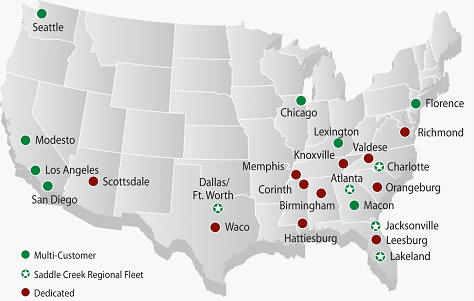
Saddle Creek added warehouses at a rapid pace, more than doubling over eight years. Its footprint has expanded at a compound annual growth rate (CAGR) of 8.6% since 2006 to 16 million square feet. Consequently, Saddle Creek’s ranking among A&A’s list of Top North American Warehousing 3PLs rose from 24 in 2006 to 17 in 2014.
| Metric | 2006 | 2014 | Change | CAGR |
|---|---|---|---|---|
| Count of Warehouses | 17 | 37 | 117.8% | 11.8% |
| Warehouse Space (in MSF) | 9.0 | 16.0 | 77.8% | 8.6% |
| A&A's Top North American Warehousing 3PLs Rank | 24 | 17 | Up7 | n/a |
Growth Outpaces 3PL Industry in North America
Saddle Creek’s revenue increased by 123% over eight years, which is a CAGR of 12.2%. Remarkably, its growth exceeded that of the 3PL industry in North America over the same time period, which A&A estimates will top $190 billion in 2014 with a CAGR of 4.5% since 2006. The Great Recession created a significant dip in 3PL industry revenue during this period; it has fully recovered. Saddle Creek never missed a beat.
| Metric | 2006 | 2014 | Change | CAGR |
|---|---|---|---|---|
| Gross Revenue ($MM) | $160 | $358 | 123.8% | 12.2% |
| Employees (including drivers) | 1,250 | 2,470 | 97% | 10.2% |
| Total Contracts | 24 | 276 | 1050.0% | 41.8% |
Total contracts surged by 10X over the period, or a 42% CAGR, which outpaced revenue growth by 4X. This is primarily due to an influx of mid-sized ecommerce clients gained through acquisition. While this has driven the average contract size down overall, the company maintains a large number of customers with high dollar contracts in both dedicated and campus environments. Saddle Creek’s multi-client distribution network is comprised of warehouse campuses, which help it to flex labor and leverage management across multiple customer operations.
Total employees grew significantly by a 10.2% CAGR, which indicates improvement in labor productivity, given a higher rate of revenue growth, as well as improved margins from higher valued-added services. Revenue contribution per employee averages $145,000 including drivers.
Organic Growth with an Acquisition Kicker
The majority of Saddle Creek’s revenue increase since 2006 was attributed to organic growth. Two strategic acquisitions in 2009 and 2010 added 18% to Saddle Creek’s warehousing footprint.
In November 2009, Saddle Creek acquired ServiceCraft Logistics, a consumer goods distribution specialist, headquartered in Buena Park, CA. The acquisition reflected Saddle Creek’s strategic focus on bringing integrated logistics solutions to new markets.
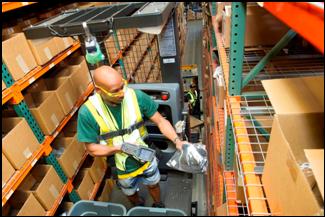
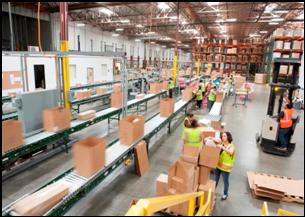
Saddle Creek gained eight warehouse locations in the key markets of Northern and Southern California and Dallas/Fort Worth. The move also expanded Saddle Creek’s transportation offering including regional fleet transportation in California and transportation brokerage.
In December 2010, Saddle Creek acquired ProLog Logistics, an eCommerce order fulfillment specialist with call center and customer care services, and locations in San Diego and Lexington, KY. Saddle Creek views order fulfillment as one of its fastest growing service segments with high growth potential, and the rapid growth of online sales certainly supports that notion. The ability to integrate eCommerce order fulfillment services with its traditional warehouse service allows the company to offer the omni-channel solutions sought after by an increasing number of companies. The strategy is paying off as revenue from fulfillment services has more than tripled since the acquisition.
Diversified 3PL Service Portfolio – Saddle Creek’s Integrated Logistics Strategy
Saddle Creek refers to its supply chain approach as an Integrated Logistics Strategy, expanding from its foundational asset-based warehousing and transportation to provide contract packaging and order fulfillment services. Currently, 80% of Saddle Creek’s customers integrate multiple 3PL services and 60% utilize multiple Saddle Creek locations. In 2006, warehousing revenue accounted for 62% of gross revenue, which was evenly split between dedicated and multi-client warehouse operations. Saddle Creek’s effort to shift toward multi-client warehousing is apparent in 2014, along with the implementation of cross-dock operations, which represented 25% and 8% of revenue, respectively.
| Revenue by Service | 2006 | 2014 |
|---|---|---|
| Warehousing Revenue | 62% | 50% |
| Dedicated Warehousing | 33% | 17% |
| Multi-Client Warehousing | 29% | 17% |
| Transportation Cross Docks | 0% | 8% |
| Transportation Revenue | 30% | 24% |
| Fleet | 30% | 24% |
| Brokerage | 0% | 9% |
| Value-Added Revenue | 8% | 17% |
| Packaging | 8% | 7% |
| Order Fulfillment | 0% | 10% |
Transportation revenue has been enhanced by the expanding transportation brokerage services, which have complemented fundamental dedicated fleet operations, and now account for 9% of gross revenue. The implementation of Saddle Creek’s Integrated Logistics Strategy has effectively doubled revenue contribution from Value-Added services with recently added order fulfillment services.
Diversifying the Customer Base with an Expanded 3PL Service Portfolio
Saddle Creek has mitigated the risk inherent in high customer revenue concentration by spreading the base. Its top 10% of customers account for 90% of revenue. However, no single customer represents more than 12% of revenue. Expansion of Saddle Creek’s 3PL service portfolio is having another positive impact of accessing new customer markets. In 2006, 85% of Saddle Creek’s Top 30 customer list was comprised of Food/Beverage, Consumer Goods and Retail. Food/Beverage and Consumer Goods continue to dominate the list in 2014. The proportion of top customers in Retail and Industrial has shifted toward Health/Beauty and Technological segments, as pallet-in/pallet-out work content shifts toward value-added packaging and order fulfillment. Saddle Creek’s customer, ipsy, is an example of the change.
| Customer Industries | 2006 | 2014 | Change |
|---|---|---|---|
| Food/Beverage | 46% | 53% | 15% |
| Consumer Goods | 23% | 19% | -18% |
| Retail | 15% | 8% | -48% |
| Industrial | 12% | 4% | -65% |
| Technological | 4% | 10% | 160% |
| Health/Beauty | 0% | 6% | new |
| Grand Total | 100%` | 100% |
Time-Sensitive Project Logistics – ipsy Cosmetics Glam Bags
ipsy is an on-line beauty community that was built around a product called the “Glam Bag.” Each month, subscribers receive a Glam Bag with deluxe samples and full-sized beauty products. Members can watch and play along with the stylists with the same products that they are using. In a few short years, ipsy’s customer list has grown to over 400,000 subscribers in the U.S. and Canada. Saddle Creek handles the logistics.
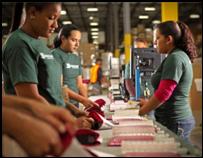
Saddle Creek receives and prepares beauty products, marketing inserts and media from ipsy’s suppliers in an order fulfillment center in Charlotte, NC. Each month is a new project, a unique set of kits with a multitude of stock-keeping unit (SKU) combinations, and a new event that requires coordination between ipsy’s media events, such as on-line styling videos and the synchronized arrival of the associated Glam Bags.
Saddle Creek creates the bills of materials and packing instructions in its SysPro IT system. Within a four-day period each month, materials are staged on multiple packaging lines for kitting, inserting, labeling and verification. Kits are reverse-sequenced based on parcel delivery zone and shipping labels are produced via ProShip, including export documentation for international shipments. Saddle Creek leverages advantageous parcel rates to deliver the Glam Bags to ipsy customers, which is really important because ipsy charges a flat rate for Glam Bags ($10 per month) and shipping is free. Saddle Creek packed and shipped more than 400,000 Glam Bags last month. ipsy’s success has seen month-over-month increases in shipment volume based on market interest in an integrated product and service offering that is highly dependent upon well-coordinated logistics.
Committed Capacity . . . Committed to the Environment
Saddle Creek provides short-haul and regional dedicated trucking services from several logistics hubs, including Lakeland (FL), Jacksonville, (FL), Atlanta (GA), Macon (GA), Charlotte (NC) and Fort Worth (TX). Its service approach is based on “committed capacity” not dedicated assets, which allows Saddle Creek to better utilize its fleet assets and lower operating costs, while maintaining 99% on-time delivery performance.
Dedicated fleet assets grew at a pace that was consistent with overall revenue growth. Saddle Creek added significantly to its fleets for dedicated contract carriage (DCC). The dedicated tractor count more than tripled since 2006. Saddle Creek added trailers for dedicated service at an even higher rate (21.7% CAGR).
| Metric | 2006 | 2014 | Change | CAGR |
|---|---|---|---|---|
| Dedicated Tractors | 66 | 205 | 210.6% | 15.2% |
| Dedicated Trailers | 99 | 476 | 380.8% | 21.7% |
The company began investing in a compressed natural gas (CNG) fleet in 2012, taking delivery of its first 40 power units at the Lakeland (FL) hub. CNG is an environmentally advantageous fuel option with nearly zero emissions and ample domestic supply. However, the infrastructure for CNG refueling is practically non-existent. Private ventures like Clean Energy Corporation are trying to rectify the situation in the long term. In the meantime, Saddle Creek built and maintains its own refueling station on-site. CNG tractors have an effective range of 600 to 700 miles, which makes regional delivery networks a viable application for the CNG fleet.
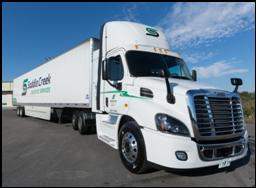
P&G is one of Saddle Creek’s premier customers for direct-to-store delivery in Georgia and Florida via the CNG fleet. The population density in the region is ideal for a dedicated regional network, especially for consumer packaged goods and food/beverage. P&G utilizes Saddle Creek’s CNG fleet as part of its own sustainability initiative. Saddle Creek handles 720 shipments per month, traveling 115,000 miles and saves about a pound of carbon for every mile traveled when compared to its diesel truck fleet. Along with P&G’s volume contribution, the current and anticipated demand for Saddle Creek’s CNG fleet has prompted it to commit to purchase additional tractors, building its fleet to over 150 including CNG fleets in Atlanta and Dallas/Fort Worth.
Moving Forward
Saddle Creek appears to have hit its stride with the Integrated Logistics Strategy, which has propelled the company forward in several positive directions with regard to its 3PL service portfolio, customer market expansion, national network footprint, and revenue growth. Saddle Creek expects to achieve double-digit growth again in 2015. It will continue to penetrate its existing customer base and expand its reach into new markets with broader, more integrated logistics solutions and value-added services, like packaging, light assembly and order fulfillment. The CNG fleet will continue to develop its niche in regional closed-loop supply chain delivery networks and serve the intentions of environmentally-conscious shippers. The company expects to keep an eye out for and prudently consider strategic acquisitions. But, it will not use acquisition as the means to grow revenue; most results will come from organic growth via operational execution of existing strategic plans.


